Kit History

March-Dec 1892 A

Dec 1892-1897 A

1897-1900 A

1900-1905 A

1905-1906 A

1906-1907 A

1907-1908 A

1908-1910 A

1910-1914 A

1914-1918

1918-1919 A

1919-1929 A

1929-1930 A
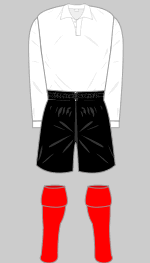
1930-1931 A

1932-Feb 1933
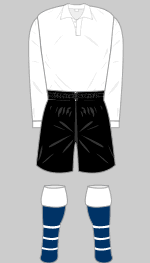
March 33-1935 A

1935-1940 A

25 Jan 36 FA Cup

29 Feb 36 FA Cup

1945-1946 A

1947-1953 A

1950 FA Cup Final

1952-1953 FA Cup

28 Feb '53 FA Cup

1953-1957 A

Aug-Nov 1957 A

4 Jan 1958 FA Cup

Nov 57-May 58 A

Aug-Oct 1958 A
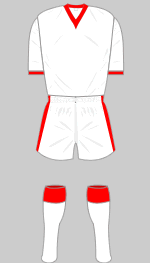
Oct 1958-1960 A

4 Apr & 26 Aug 59

1959-1960 A (2)

1960-1961 early

1960-1962 A

1962-1964 A

Dec 64-March 65 A

March 1965 A

1965-1968 A (1)

1966-1968 A (2)

10 Dec 1966 3rd

1967-Nov 1968 A

Nov 1968 A

Dec 68-1976 A (1)

1969-1976 A (2)

3 Jan 1970

15 Jan 1970

25 March 1975
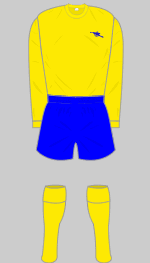
1976-1977 A (1)

1976-1977 A (2)

1977-1978 A

1978 FA Cup Final

1979 FA Cup Final

1981-1982 A

1983-1986 A

1986-1988 A

1991-1993 A

1993-1994 A

1994-1995 A

1994-1996 3rd

1995-1996 A

1996-1997 A

1997-1999 A

1998-1999 Eur

1999-2001 A

2001-2002 A

2000-2002 3rd

2002-2003 A
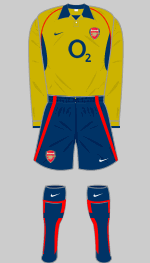
2002-2003 3rd
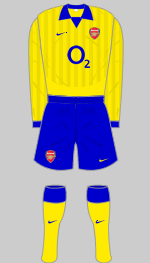
2003-04 A 3rd 04-05

2004-05 A 3rd 05-06

2005-2006 A

2006-2007 A
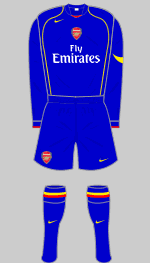
2006-2007 3rd

2007-08 A 3rd 08-09

2007-2008 3rd

2008-2009 A

2009-2010 A

2009-2010 3rd

2010-2011 A 3rd 12-13

2011-2012 A a

2011-2012 3rd

2012-2013 A

2013-2014 A

2014-2015 A

2014-2015 3rd
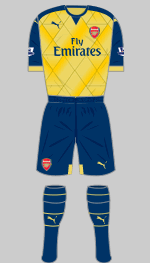
2015-2016 A

2015-2016 3rd
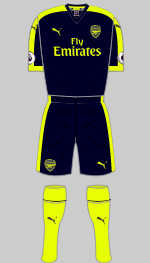
2016-2017 3rd

2017-2018 A
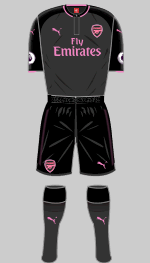
2017-2018 3rd

2018-2019 A

2018-2019 3rd

2019-2020 A

2019-2020 3rd
Background
 The first reference to Arsenal wearing a change of shirts comes from 26 March 1892 when they wore blue and white stripes against Everton (who wore red at the time) to the confusion of their supporters. This was discovered by Andy Kelly and Mark Andrews who also established that they wore stripes again on 17 December 1892 against Nottingham Forest. A week after the Forest match, Arsenal wore white tops against Burslem Port Vale and this became their regular alternative until 1908.
The first reference to Arsenal wearing a change of shirts comes from 26 March 1892 when they wore blue and white stripes against Everton (who wore red at the time) to the confusion of their supporters. This was discovered by Andy Kelly and Mark Andrews who also established that they wore stripes again on 17 December 1892 against Nottingham Forest. A week after the Forest match, Arsenal wore white tops against Burslem Port Vale and this became their regular alternative until 1908.
Between 1908 and 1910, navy tops and knickers were worn but white shirts returned in 1911. The all-navy strip seems to have been worn again immediately after the Great War: Andy Kelly and Mark Andrews have discovered that navy shirts were probably used until 1929, albeit with white knickers.
Denis Hurley has uncovered a hooped top (confirmed by Kjell Hansen to have been red and white and worn against Barnsley in the FA Cup), a black and white vertical striped shirt worn at Blackpool also in the FA Cup in 1953 (and possibly on other occasions too) and we also have evidence of the team wearing blue and white versions of their famous home shirt in the late 50s.
On Arsenal 15 April 1950 wore gold shirts at Highbury against Newcastle, a try-out for the FA Cup final against Liverpool, which Arsenal would win 2-0. These shirts made several more appearances right up until 1958.
In the mid 1960s wore a bewildering number of variants on their first choice and change strips. I am grateful to Simon "Shakey" Shakeshaft and Daniel Gellatley for permission to use their illustrations.
1966-67 Variants | 1967-68 Variants | 1968-69 Variants
For the 1967-68 season, Arsenal wore navy blue shirts when colours clashed, a kit identical to Spurs' change kit of the time.
In 1968 the FA banned navy shirts (they looked too similar to referees' black kit) so the Gunners turned out in yellow shirts and blue shorts for the first time in November, an outfit that recalled that FA Cup win of almost 20 years previous. (The navy and white strip did reappear in November 1970 in an FA Cup tie at Blackpool.) This yellow and blue strip became almost as famous as their iconic red and white home kit and was worn, with minor changes to the design of the collar and the addition of a sponsor's logo in 1981, right through until the end of the 1981-82 season. During this period Arsenal, like Leeds United, took to wearing their change kit when playing away from home regardless of whether there was a colour clash. This practice gave rise to the term "away kit" that is now universally used rather than the more accurate "change kit."
(Peter Rapley had discovered that in March 1975 the Gunners wore all-white at Luton, presumably because both their red and yellow kits were too similar to the orange tops worn by the home team at the time.)
In 1982 Umbro introduced what became known as the "bluebottle strip," a mirror image of their new home kit but in green and navy blue. The kit proved unpopular with supporters and was replaced the following season by a rather more traditional affair that substituted navy for royal blue and, for the first time, incorporated red trimmings.
In 1986 Adidas took over as Arsenal's kit manufacturer whose designs included their trademark three stripes, each edged in a contrasting colour. Among the spectacular designs introduced in the 90s was the infamous "bruised banana" strip (1991-93), a kit that consistently appear near the top of any poll of the worst kits ever.
Nike took over from Adidas in 1994 and their radical reinvention of the Gunners' kits included navy and turquoise away kits (a yellow and navy shirt was also available but used only twice). Yellow, then deep gold reappeared at the end of the decade and in 2000, the shirt was rendered in metallic gold. In 2002 Nike introduced a revolutionary shirt in navy blue with a striking geometric pattern on a broad vertical panel. the 2002-03 season was also the first time that the club recycled their previous change kit as a third choice kit for the following season. This practice is now widespread and allows the top clubs to retain kits for two seasons while introducing a new line each year.
Arsenal have continued to sport dramatic away kits, including dark grey shorts matched with yellow shirts (2005-07), white shirts with redcurrant shorts (2007-08) and redcurrant and "obsidian" hoops (2007-08).
You are welcome to Contact Me with corrections and additions.
Sources
- A = Away (change) kit
- 3rd = Third kit
- FA Cup = FA Cup change kit (both teams changed if kits clashed in the FA Cup. These kits were used when both first and second choice kits clashed).
- Eur = European change kit










